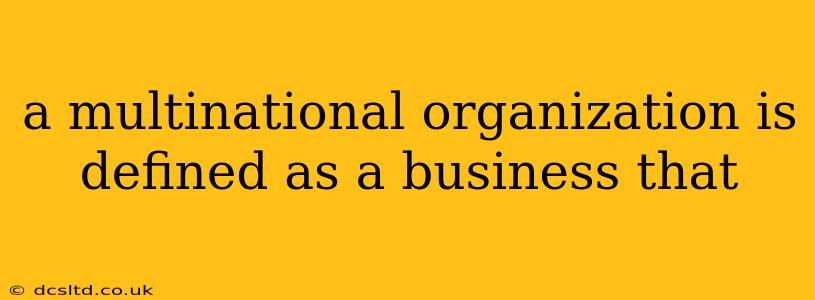A multinational organization (MNO) is defined as a business that operates in multiple countries, leveraging global resources and markets to achieve strategic objectives. It's more than just a company that exports or imports goods; it establishes a significant presence in various nations, often with subsidiaries, branches, or wholly-owned operations. This global reach distinguishes it from purely domestic businesses. Understanding the nuances of MNOs is crucial for navigating the complexities of international trade, economics, and business strategy.
What are the key characteristics of a multinational organization?
Several key characteristics define a multinational organization:
-
Operations in multiple countries: This is the defining feature. An MNO doesn't merely sell products internationally; it has substantial business operations—production, sales, marketing, research and development—in several countries.
-
Decentralized management structure: Often, MNOs adopt a decentralized structure, empowering local management teams to adapt to the specific needs and regulations of their respective markets. This contrasts with a centralized structure, where decisions are made primarily at headquarters.
-
Global integration of resources: MNOs strategically utilize resources from across the globe—labor, materials, capital—to optimize efficiency and cost. This integration is a crucial element of their global competitive advantage.
-
Cross-border transactions: MNOs engage in significant cross-border transactions, including the transfer of goods, services, capital, and knowledge across international borders.
-
Cultural sensitivity: Successful MNOs demonstrate a high level of cultural sensitivity, adapting their products, marketing strategies, and management styles to align with the local cultural norms and preferences of their target markets.
What are the advantages of being a multinational organization?
The advantages of operating as a multinational organization are significant and contribute to their global dominance in various sectors:
-
Access to larger markets: Expanding into multiple countries allows MNOs to tap into significantly larger consumer bases, boosting revenue and market share.
-
Reduced costs: By leveraging lower labor costs, cheaper raw materials, or more favorable tax regulations in certain countries, MNOs can significantly reduce their overall production and operational costs.
-
Diversification of risk: Operating in diverse markets hedges against economic or political instability in any single country. If one market experiences a downturn, others may still perform well, mitigating overall risk.
-
Access to talent and resources: MNOs can recruit skilled workers and utilize resources from diverse geographical locations, fostering innovation and enhancing their competitive edge.
-
Enhanced brand reputation: A global presence often enhances brand recognition and reputation, leading to increased consumer trust and loyalty.
What are the disadvantages of being a multinational organization?
Despite the many advantages, operating as an MNO presents challenges:
-
Increased complexity: Managing operations across multiple countries is significantly more complex than managing a domestic business, requiring expertise in international law, finance, and cultural nuances.
-
Higher risk: MNOs face increased risks, including political instability, currency fluctuations, regulatory changes, and cultural misunderstandings in different markets.
-
Communication challenges: Effective communication and coordination across geographically dispersed teams and operations can be challenging, requiring robust communication systems and strategies.
-
Ethical considerations: MNOs often face ethical dilemmas related to labor practices, environmental regulations, and social responsibility in different countries with varying standards.
How does a multinational organization differ from a transnational organization?
While both operate internationally, there's a key difference. A multinational organization retains a strong national identity and centralizes management in its home country, whereas a transnational organization integrates its operations globally, with less emphasis on a single national identity and a more decentralized management structure.
What are some examples of multinational organizations?
Numerous companies operate as multinational organizations across diverse industries. Examples include Apple, Coca-Cola, McDonald's, Toyota, and Samsung. These companies demonstrate the scale and reach achievable through a global presence.
In conclusion, a multinational organization is a business that strategically operates in multiple countries, leveraging global resources and markets to achieve sustained growth and competitive advantage. Understanding the complexities, advantages, and disadvantages inherent in this model is critical for businesses seeking to expand their reach and compete on a global scale.
